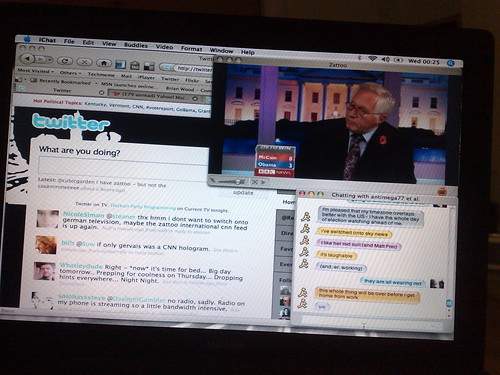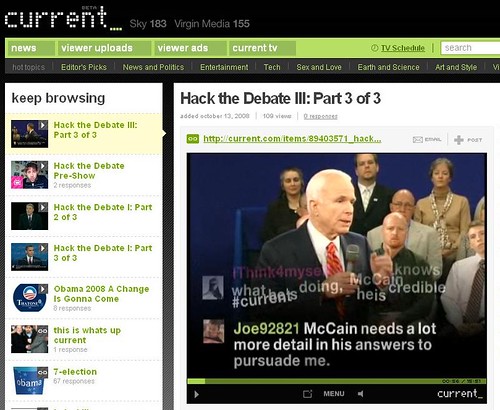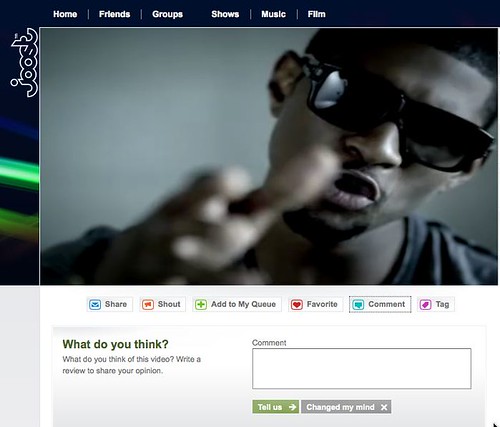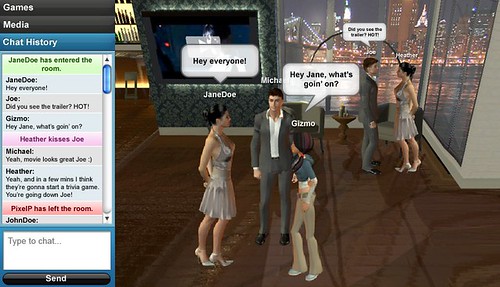 Okay, so you’ve heard from someone that this social media and social networking stuff is great and you should get involved, and it’s really going to help you out. Maybe it will help you in the economic downturn. Maybe you have heard how you can use Twitter for business. But there’s a lot to it all.
Okay, so you’ve heard from someone that this social media and social networking stuff is great and you should get involved, and it’s really going to help you out. Maybe it will help you in the economic downturn. Maybe you have heard how you can use Twitter for business. But there’s a lot to it all.
Where would you start? What would come first? How might you think about getting out there and joining in on the experience?
Here’s what I’m going to do. I’ll build three different scenarios out, and give you the starting points for what I’d do with social media if I were in these steps. Try to extrapolate them out to your profession or your need. If you really want to have fun with this post, take what I’ve started here, and write your own post for your vertical or condition, and then be sure to share the ideas with us here, so we can go to your site and check it out. (We’ll even be able to visit via trackbacks, if you link back to the original post).
Before it All: Listening
(Note: this was updated after Lucretia pointed out that I probably inadvertently forgot to mention it.)
Listening is my first move in starting to understand social media. That means this: go and read the blogs that are out there. Read from different genres. Go visit Twitter.com and more importantly search.twitter.com, and see what people are saying. Read comments on people’s blogs and see which ones seem to get any response. Search using Google and Technorati.com, and start listening to conversations that are out there.
And then, start here.
First Platform: A Blog
No matter what, the very first piece of social media real estate I’d start with is a blog. It’s a website, with lots of built in features that make it useful from a search perspective, and simple from a content creation perspective. That alone is worth the price of admission.
Don’t worry as much about the features, although certain companies make blogging platforms that go above and beyond simple content publishing. Don’t focus hard on the add-ons and whizbangs, but do know that a bare bones, out of the box blog is about as appealing as two slices of bread with a piece of bologna on it.
Now, let’s break that into three potential scenarios.
Personal branding: I’d buy my own domain name, and host it somewhere inexpensive, but with good service.
Company communications: I’d use an off-brand domain, with a “powered by” mindset, similar to Digital Nomads by Dell. Meaning, I wouldn’t necessarily do a “product blog” or a “corporate voice” blog as much as I’d want to do a “something useful to people” blog. Exceptions: really big corporations with lots of bloggers, like Sun, IBM, Cisco, etc.
Nonprofit: I’d start a storytelling and pictures blog about the causes I was tasked with supporting. No question about it: stories and pictures are powerful contributors to nonprofit experiences.
For blog topics and other ideas, I’ve collected my best advice, and that should get you started there.
Second Step: Outposts
In all cases, I’d build outposts which help me reach into lots of different places and communicate with people where they might be. Depending on my needs, I might use different tools. At the very minimum, I’d start accounts on:
- Twitter
- LinkedIn
- Facebook
I might or might not then pick one or two more specialized networks. Let’s look at how this works for our three examples.
Personal: use Twitter to build relationships and share interests. Use Facebook to learn about groups and events of interest. Keep LinkedIn active and updated, and stay involved in the answering of questions part of the site. Goal here: keep your name out there, far ahead of when you might need anything from anyone.
Company: use Twitter as a way to show that you’re humans in there. I like how Dell has several namesatDELL type accounts like RichardATDell and LionelATDell, etc. You could also just be yourself, like ScottMonty from Ford, or astrout(Aaron Strout) from Powered. Use Facebook as individuals and LinkedIn as individuals, but with a group purpose. You might participate in other people’s groups. You might find friends with like interests or similar demographics and reach out to them that way. Be human. That’s the main goal here.
Nonprofit: depending on the cause, you could either use Twitter as the cause name, or you can reach out as an individual. There are both in the field, and I’ve yet to see which is more productive. Maybe a nonprofit can comment on their experiences here. On Facebook and LinkedIn, be the individual, but form groups around your causes, and invite people who might be like minded into the groups.
With all three groups, the specific networks I mentioned at the beginning of these segments would obviously vary. One note: don’t use those tools that push your status across multiple platforms. I understand that it’s simpler to update things that way, but it also means that you don’t respect your individual audiences at those outposts.
In all cases, use your picture for the avatar, not a logo. Try to get a candid shot that’s not a stuffy professional photo, but one that isn’t a cropped picture of you next to some ex relation.
In all cases, put enough information in your profile to connote that you’re at once a business person as well as a human being. In Facebook, consider which applications you add to your profile. Yes, being a pirate or a vampire might be fun, but it might also make someone question your professional intent. But do feel free to share your interests in books or movies or sports, and make sure your status messages aren’t always and forever about your business interests, or people might be less engaged after a very short amount of time.
I also have my best advice about social networking to help you there, too.
Third Step: Audience
Once you have a primary place to express yourself (your blog), and a few outposts where you can communicate in a less structured, more real time way (outposts), the next then I would do is find like minds. It depends on your business goals what you might do with this audience, and for some people, this might not apply as much. For the three examples I gave, it would be an important thing to build a level of followership and interaction across your platforms, so we’ll cover this all as one group, not as separate goals.
My best advice about building community and audience is this: be helpful. Write blog posts that others can use (like this one, for instance). The more you can help others, the more they’ll come back.
Avoid writing “me too” blog posts about the latest news in your vertical. Chances are, someone else is doing it better, and your “me too” is just a throat-clearing proof that you’re not creating original content. Work harder on doing something original instead of just pumping out “I read this article about” types of posts, unless you’re going to expand on the ideas, and/or recast them for your particular audience.
If you’re writing for a company, maybe these blog topics will spark some ideas. If you’re writing a personal blog, here are 100 blog topics to get you started.
More important in growing a community: comment. Go out to other people’s blogs and start getting involved. Use a service like BackType to learn what other people are saying and where they’re commenting. The more you make your voice heard in the general space where you want to do business, the better you’ll be.
Note something important: you might want to think about commenting in two places. First, where your peers are writing their stuff makes sense as a place to comment, but that will only bring you into a better relationship with your peers in a space. If you want to start building business, start learning to comment on your customers’ blogs, in your customers’ verticals, where your customers are spending their online time.
Fourth Step: Experiment
If something’s not working, try something else. If you’re not using analytics and stats packages to learn more about your web visitors, you’re missing out. If you aren’t learning how these social media elements tie to your business, and you’re just using them as another isolated thing, then you’re missing the whole reason to start (for businesses, at least).
Experiment. Try new things. I try something new every day. It might be a blog post. It might be a strategy about how I can get more people to do X instead of Y. It might be something as simple as reaching out to other people in new ways. But experiment. If you just sit around doing the same things you did to start out, you might as well turn in now.
I just gave myself another idea even writing this post. That’s the power of experimenting. You learn by doing, not reading. So, read all this, but then do something.
Your Turn
What would you tell people about starting out? If you want to adapt this to your specific blogging or media making interest, what would you tell people differently? How else might you serve your community?
Or, what do you have further questions about? This would be a great post to encourage people to ask questions, and share with the rest of the larger community.
What do you need to start today?
 Wallets don’t mix with skinny jeans, and since we hope cargo pants won’t be back anytime soon, we’re eagerly anticipating m-commerce.
Wallets don’t mix with skinny jeans, and since we hope cargo pants won’t be back anytime soon, we’re eagerly anticipating m-commerce.















